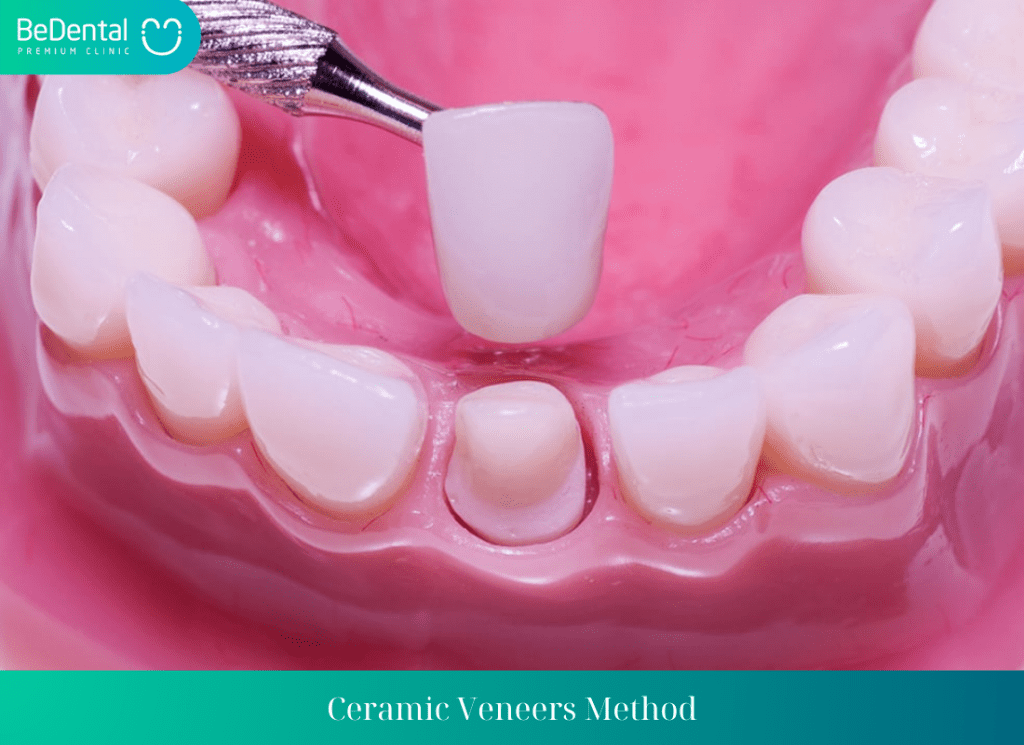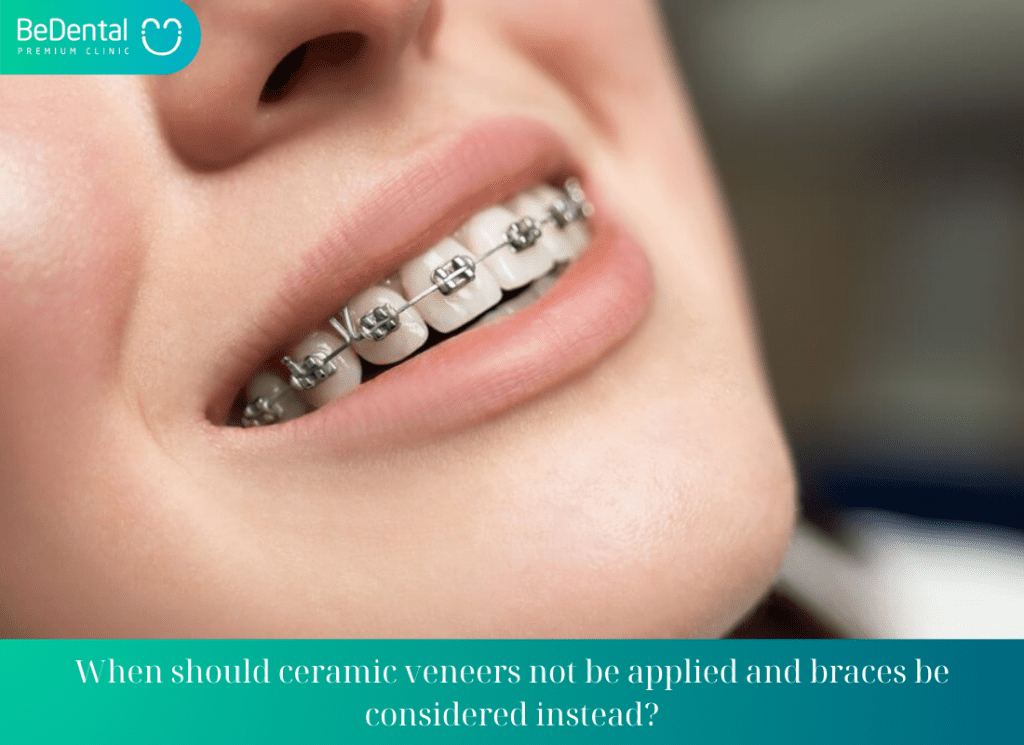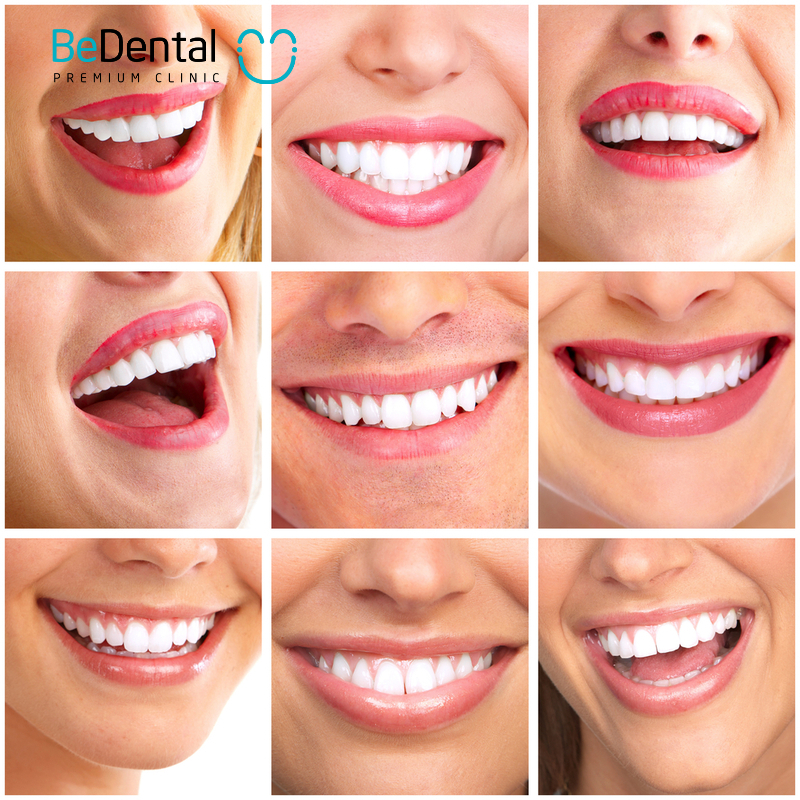Whether to Get Braces or Ceramic Veneers is a common question in improving dental aesthetics. Due to the differences in implementation methods, each approach is suitable for different dental conditions. Below is an analysis and comparison between braces and ceramic veneers to help customers choose the appropriate method for themselves.
Braces or Ceramic Veneers: Pros and Cons
With the outstanding development of dental technology, there are various methods available to address dental imperfections and achieve even, bright teeth and a perfect smile.
Among them, braces or ceramic veneers all stand out. They have the ability to improve issues such as crooked teeth, protruding teeth, gaps, misaligned teeth, and many other cases.

Braces Method. Braces or Ceramic Veneers: Pros and Cons
The braces method is a dental technique that uses special tools such as brackets, wires, springs, and mini screws to apply force and move teeth to the desired position in the jaw arch. After the braces are removed, the user will have evenly beautiful teeth and a correct bite position.
See more: What Is the Appropriate Age for Braces?
Advantages:
- When choosing braces, you do not have to worry about invasion or damage to the natural structure of the teeth. The braces process only impacts the tooth roots while maintaining the original tooth health.
- The braces method is the optimal solution to correct bite-related issues such as protruding teeth, crooked teeth, misaligned teeth, gaps, from mild to severe.
- There are many types of braces to choose from, such as traditional metal brackets, ceramic/ crystal brackets, lingual braces, clear aligners… This meets the diverse needs and dental conditions of each user.
- The tooth adjustment tools are very safe, non-irritating, and suitable for many user profiles.
Disadvantages:
- The braces process usually lasts from 12-24 months or longer. Additionally, users have to visit the dentist multiple times for adjustments.
- When wearing braces, the use of brackets, wires, etc., can easily be visible when smiling, talking, affecting the facial aesthetics.
- The braces method does not improve the color of teeth or repair broken, cracked teeth.
See more: What is Orthodontic archwire
Ceramic Veneers Method. Braces or Ceramic Veneers: Pros and Cons
The ceramic veneers method is used to enhance the aesthetics of teeth by grinding and placing a layer of porcelain enamel on natural teeth. Porcelain veneers are formed with natural shape and color, creating aesthetic harmony between teeth after being veneered.
At the same time, this ceramic veneers method does not affect the chewing function.

Advantages:
- Ceramic veneers not only correct imperfections such as broken teeth, protruding teeth, deep cavities, but also improve the color of teeth, especially teeth that are yellowed due to antibiotic staining or food. This results in whiter and brighter teeth for the user.
- There are many types of ceramic veneers available at different prices for users to choose according to their preferences and needs.
- Improve chewing function and facial aesthetics.
- Quick implementation time, with the process of veneering ceramic teeth completed in just 3 days.
See more: Signs of gum recession during braces
Disadvantages:
- The process of applying ceramic veneers requires grinding teeth and affects the natural tooth structure, which may cause tooth sensitivity.
- Not suitable for people with sensitive teeth, underlying conditions, or severe bite misalignment.
- Despite their high durability, ceramic veneers are still artificial teeth, so the lifespan of ceramic teeth cannot be extended indefinitely.
Which is better, braces or ceramic veneers?
Which is better, braces or ceramic veneers? Both braces and ceramic veneers are effective methods to correct protruding teeth. However, the decision between braces and ceramic veneers depends on the condition of protruding teeth, comfort in using brackets, desire to perfect the shape of teeth in a short period, and the financial ability of each individual. Based on these factors, the dentist will advise and propose braces or ceramic veneers treatment plan.
See more: What is Abutment?

Below is a comparison table for your reference to better understand your needs and preferences:
| Braces | Ceramic Veneers | |
| Suitable Age | Recommended age for braces treatment is from 12 to 16 years old, when permanent teeth have fully replaced baby teeth. At this age, the jawbone is in a growth phase, facilitating tooth adjustment and alignment. | Suitable age for ceramic veneers treatment is from 18 years old and above, without affecting oral health. |
| Treatment Technique | tilizes tools like brackets, wires, or aligners to apply force on the teeth and gradually move them to the desired position. | The process of applying ceramic veneers involves grinding natural teeth to a certain ratio. Then, teeth will be imprinted and appropriate porcelain veneers crafted.
The ceramic veneers will be permanently attached to the teeth using specialized adhesive |
| Impact on Teeth | Initially, in some cases, tooth extraction may be suggested to create space, aiding easier tooth movement. | Requires grinding of natural teeth |
| Completion Time | 12 – 24 months | 3 – 7 days |
| Effectiveness | Straighten teeth, correct bite alignment | Teeth become more uniform, color is improved to be whiter |
| Care Routine | Requires meticulous care to ensure that food and plaque do not get stuck in brackets, wires, or other related components | Simple care like natural teeth |
See more: Dental implants
Dental Factors to Consider When Choosing Between Braces and Ceramic Veneers
When choosing braces or ceramic veneers for dental treatment, several important factors should be taken into consideration to make an informed decision. Here are some key factors to consider:
- Treatment Objective: Determine the primary goal of the treatment. Braces are typically used to correct misaligned teeth and bite issues, while ceramic veneers are often chosen for cosmetic purposes to improve the appearance of the teeth.
- Severity of the Issue: Consider the severity of the dental concern. Braces are more suitable for significant misalignments, overcrowding, or bite issues, while ceramic veneers are ideal for minor alignment issues or aesthetic improvements.
- Longevity: Evaluate the longevity of the treatment. Braces provide a permanent solution for correcting misalignments, while ceramic veneers may need to be replaced every 10-15 years depending on care and maintenance.
- Aesthetics: Assess the desired aesthetic outcome. Ceramic veneers can instantly improve the appearance of the teeth by correcting discoloration, gaps, and minor misalignments, while braces may be more noticeable during the treatment period.
- Oral Health: Consider the impact on overall oral health. Braces may require more stringent oral hygiene practices to prevent issues such as decay or gum disease, while ceramic veneers may require minimal maintenance but involve altering the natural tooth structure.

- Cost: Compare the cost of braces and ceramic veneers. Braces may be a more cost-effective option for orthodontic treatment, while ceramic veneers tend to be more expensive due to the materials and customization involved.
- Time Commitment: Evaluate the time commitment required for each treatment. Braces typically require a longer treatment duration, ranging from several months to a few years, while ceramic veneers can be completed in a few visits.
- Consultation: Lastly, consult with a dental professional to discuss your specific needs, preferences, and expectations. A dentist can provide personalized recommendations based on your oral health condition, treatment goals, and budget.
By carefully considering these factors when choosing between braces and ceramic veneers, you can make an informed decision that aligns with your dental needs and preferences for optimal treatment outcomes.
When should ceramic veneers not be applied and braces be considered instead?
The belief that ceramic veneers are the solution for overbites, crooked teeth, protruding teeth, and gaps is a common misconception that could potentially harm oral health.
It is important to note that ceramic veneers are not always suitable. If you fall into any of the following cases, consider braces instead of ceramic veneers:
- Severe bite misalignment due to jaw bone structure: When the jaw bone is overgrown or misaligned, or when there are crowded, overlapping, or crooked teeth, braces may be a better method to adjust the jaw bone structure.
- Sensitive teeth or desire to preserve natural teeth: If you have sensitive teeth or want to preserve your natural teeth without grinding them, ceramic veneers may not be suitable. Instead, other treatment methods like braces or alternative tooth preservation methods can be considered.
- Severely damaged teeth due to cavities, periodontal disease, severe infection, loose teeth, or high risk of tooth loss: In such cases, undergoing a dental implant evaluation may be a suitable method to address severe tooth damage and the risk of tooth loss.

The above article has helped you answer the question: “Braces or Ceramic Veneers?”. Contact Bedental if you want advice on appropriate methods to have more precious information, we will provide free help 24/7.
See more: Do braces cause toothloss?





